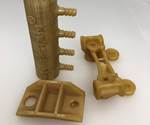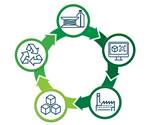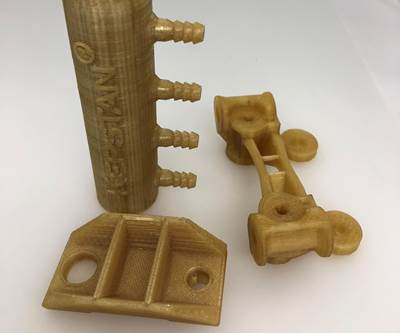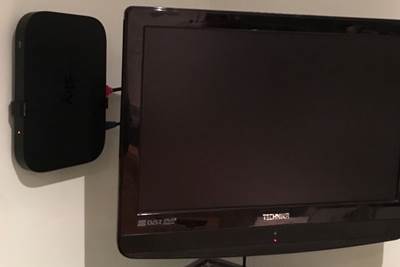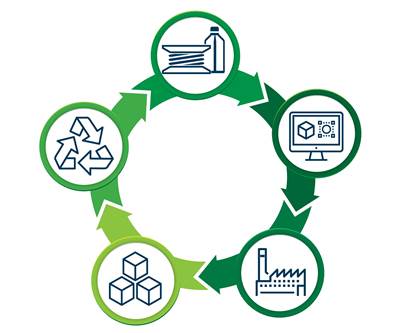Why “Recycled” Doesn’t Mean Inferior for 3D Printing Filament
GreenGate3D’s PET-G filament is made from recycled plastic, but that doesn’t diminish its quality. How a recycler found a new business opportunity in 3D printing, and how this success might point the way to a more effective recycling ecosystem.
Rich Silberfeld sells filament for 3D printing. But he doesn’t come from a manufacturing background or work for a large chemical company. Instead, he’s a recycler.
Silberfeld is president of Universal Composites, a business he took over from his father about 20 years ago. The New York-based company reclaims plastic waste to be recycled back into the supply chain. Universal Composites’ focus is not on recycling the material itself, but on sourcing and processing plastic to be passed on to compounders, extruders, pelletizers and others who can turn this scrap back into feedstock.
But recently, Silberfeld saw a business opportunity in one particular type of scrap Universal was already collecting. In 2018, he launched a second company called GreenGate3D. Its mission? To enter the 3D printing marketplace as a materials provider, starting with a filament made from recycled PET-G plastic.
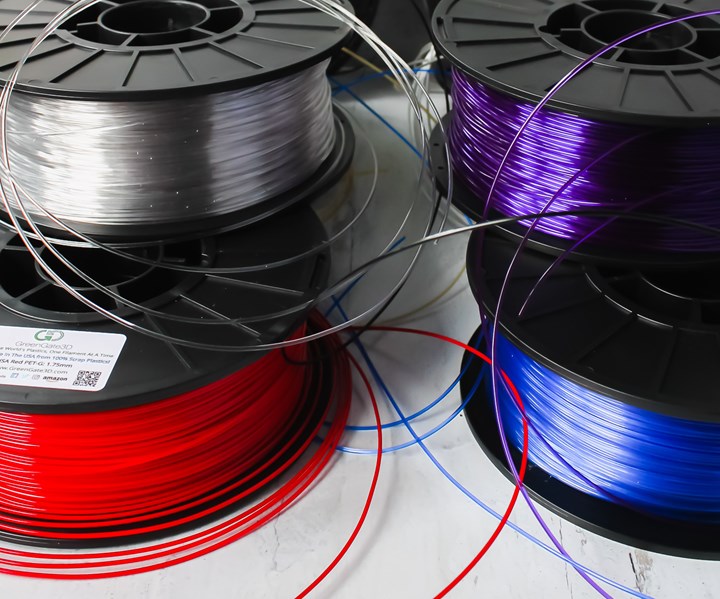
Silberfeld’s 3D printing filament company GreenGate3D offers PET-G filament and pellets, all made from recycled plastic. Photo: TiffanyC Photography
Turning PET-G Scrap into 3D Printing Filament
“Initially, I didn’t really want to be a filament manufacturer,” Silberfeld says. “That’s a giant responsibility, selling retail and making a product. I would rather supply the raw material.”
This is how Universal Composites has operated for a quarter of a century, purchasing scrap and processing it to sell to buyers. The business model is predicated on strong relationships on both sides; Silberfeld has to trust his suppliers to deliver the same quality of scrap each time, and on his buyers to dependably purchase this material. Selling a product outright to consumers was a riskier move, but it helped that the material source was already solidified.
“When we started looking at other industries to get into, I looked at my supply chain and asked, ‘What do I have that can fit in a new industry?’” Silberfeld says. Universal’s PET-G supplier immediately came to mind. “I’ve been to their facility a number of times, and we’ve sold the material into other industries. But really, it’s perfect for 3D printing,” he says.
PET-G (or polyethylene terephthalate glycol) is a translucent and durable polyester-based thermoplastic commonly used in industrial sheeting as well as vacuum- and thermoforming applications. In 3D printing, the material offers low shrinkage, high strength and a glossy sheen, and is typically food-safe.
Recovering PET-G plastic from post-consumer waste can be challenging, as the material is often contaminated with sticky residues from food and drink. But GreenGate3D collects post-industrial waste, which mitigates many potential cleanliness and quality control issues. The PET-G plastic scrap it receives is of a high grade and clean when it arrives from the source. That makes it easy to process and results in a better 3D printing feedstock.

The PET-G scrap is sourced from sheets (left) and then re-processed into pellets (center). GreenGate3D’s partners extrude the pellet into filament and wind it onto spools (left). Photos: GreenGate3D
“The scrap that we’re using as the base raw material is such a high-end product that its clarity even beats virgin material already used in 3D printing,” Silberfeld says. The quality of the scrap carries through to the filament, with early beta users (found via Facebook) reporting good results in use.
Over the past two years, GreenGate3D has developed a line of PET-G filament available in 12 different colors, with industrial products like “safety orange” debuting in March 2020. The company works with third-party extruders to produce this white-labeled material, which it sells through its website and on Amazon. The recycled pellets used as GreenGate3D’s filament feedstock are also available.
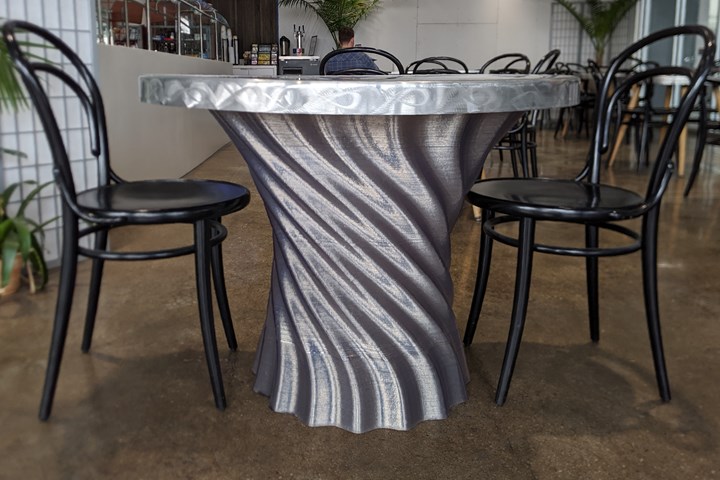
GreenGate3D customer PicoSolutions 3D printed this table using the company’s PET-G pellets. Photo: PicoSolutions
3D Printing As a Market for Recyclables
GreenGate3D’s source of clean scrap is the enabler to its high-quality PET-G filament. But the success of this product is equally dependent on Silberfeld’s correct guess that 3D printing users would buy such a filament if it were available.
“We have to know our supply and where it’s coming from, but we also have to know who we’re selling to,” Silberfeld says. When recycling doesn’t happen, it’s not necessarily because the material is unsuitable. There are some scrap materials that Universal Composites won’t pursue because they will be too difficult to sell. If no buyer can be found, the scrap simply remains scrap.
Reshoring Recycling
The point applies just as well to the global recycling ecosystem. Consumers are increasingly aware of the fact that China previously purchased the bulk of the world’s plastic waste, and is now turning this material away. Used plastic from the United States is being diverted to other Southeast Asian countries where it can be recycled (at best), incinerated, buried in landfills, or dumped (at worst). The system isn’t sustainable, and better solutions for used materials are needed. With the Asian market for recyclables closing, companies like GreenGate3D are finding a new one closer to home in 3D printing.
GreenGate3D prides itself on being a U.S.-based business that converts U.S. scrap into filament on U.S. soil. That’s a sales draw, of course, and it makes business sense. But the implications go deeper; there are real sustainability wins to be found in bringing recycling closer to its material sources.
If a nation’s scrap can be collected, recycled and sold within its borders, that dramatically reduces shipping compared to transporting that scrap overseas and then shipping it back as feedstock or products. Reduced shipping means a smaller carbon footprint to recycle that scrap, as well as shorter lead time for the material to transform from usable product to usable product.
What was once industrial waste from a conventional process could now find new life as the next generation of parts and products, manufactured with a method predisposed to material frugality.
That Greengate3D’s PET-G is finding new life via 3D printing is significant, too. What was once industrial waste from a conventional process could now find new life as the next generation of lightweight parts and products, manufactured with a method predisposed to material frugality.
GreenGate3D’s 3D printing filaments performed well with beta testers and have rapidly grown in popularity among hobbyists. Now, Silberfeld is setting his sights on industrial users. He plans to scale up production and add lines of filament made with recycled HIPS, nylon, flexible TPU and more soon.
“I’ve got to get PET-G under control first,” he says, because “the demand has arrived.”
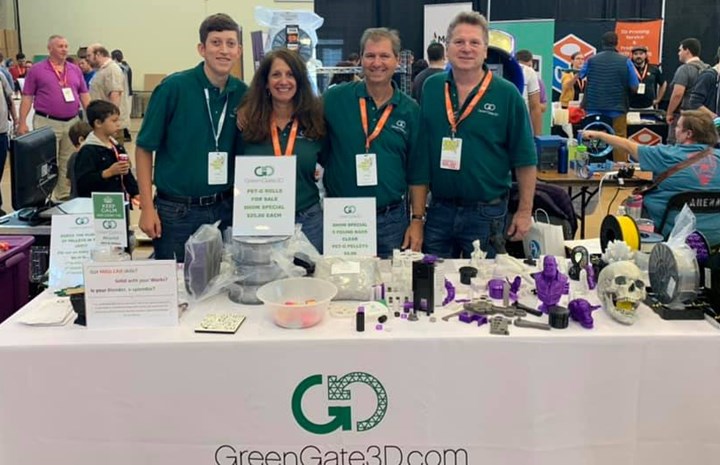
The GreenGate3D team at ERRF2019, from left to right: Benjamin Levine, printing engineer; Barbara Silberfeld, business director; Richard Silberfeld, president; and Ray Brown, director of operations. Photo: GreenGate3D
Related Content
Velo3D Chooses Continuum Powders for First Sustainable Metal Powder Offering
OptiPowder 718, based on Ni 718 alloy, is the first-ever 100% recycled, sustainable metal powder option made available in Velo3D Sapphire printers.
Read MoreAmerica Makes’ Summer Research Project Call Worth $2.1 Million
The RFP includes 6 topic areas of focus with research project proposals due by August 16, at 5 p.m. (ET).
Read MoreContinuum Powders Creates Energy Partnerships With Priority Power and AirGas
Continuum is contracting to secure some of the industry’s greenest sources for power and argon gas. When the entire combination of the new renewable energy sources are added with its proprietary process, the company anticipates a total energy consumption of nearly zero.
Read MoreAmerica Makes Names Winners of EARTH Project Totaling $1.2 Million
Recipients of America Makes’ EARTH project awards will explore sustainable approaches for reusing and recycling additive manufacturing materials and designs. Their initiatives are expected to make substantial contributions to reducing waste, conserving energy and mitigating carbon emissions
Read MoreRead Next
Ultem, PEEK or PEKK? Choosing Between High-Temperature Plastics
How do you choose between these high-performance materials? A conversation with Arkema and Plural AM sheds light on 3D printing with these polymers.
Read MoreHow 3D Printing Enables Sustainability in a High-Turnover Consumer Market
Pengraff UK built its business initially providing mounting solutions for routers and telecommunications equipment, hardware with built-in obsolescence. 3D printing and sustainable materials enable the company to live its values while manufacturing products with a limited lifespan.
Read MoreAdditive Manufacturing Will Aid And Accelerate The Circular Economy
A circular economy links material, design, manufacturing, product and end-of-life in a continuous, sustainable loop. This special report illustrates the roles for 3D printing every step of the way.
Read More
.jpg;width=70;height=70;mode=crop)
